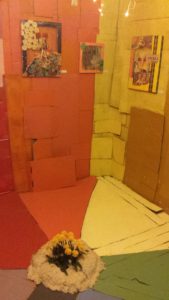This weekend it was my honor and delight to preview Desiree Duell‘s new installation “Homebody,” (or, rather, a series of connected exhibits) created and assembled as a part of her MFA thesis for University of Hartford. Desiree is a good friend of mine and I’ve been convinced of her brilliance ever since we first worked together on the Our Town residency back in 2013, so you won’t be surprised to hear that I was impressed with Homebody as well.
But for most Flintstones, you’ll have just one opportunity to experience this project, from 1 – 10 PM on Friday, June 8th, 2018. That’s tomorrow, and the weather is supposed to be fine, school is out for the summer, and the streets will be full of smoke, laughter, and the smell of barbecue. I really, really urge you to stop by 810 S. Franklin in Flint’s College-Cultural Neighborhood to check it out.
The reason it’s worth sharing the sights and sounds and smells of early summer is that Homebody inhabits its name perfectly. So much of its power derives from the fact that it is not based out of a gallery or storefront, but out of a very lived in home and you can almost feel the daily routines playing out in the air about you as you take in the installation’s sites.
“When Apologies Are Too Late,” in which you confront a year’s worth of full and empty and hung and filagreed plastic bottles, shares the space with a functional kitchen. “Washing Away Snyder’s Sins” makes a second story bathroom resemble a scene from Psycho, and there are more than a couple things you can read into that. “In All Of Her Positions” is an intimate collection of collages, mementos, and reflections gathered in the artist’s bedroom. And, most poignantly, “Moonlight’s Magic,” in her son’s bedroom, features a series of woven “God’s Eyes” he made to protect the house and his inhabitants after a spate of violent crime in the neighborhood a year ago.
Homebody is a multi-dimensional project with plenty of political and social observation, often asking questions and occasionally offering answers. The water crisis looms large in many rooms, but others deal with pervasive and persistent aspects of poverty, exclusion, and institutional violence directed against women and the poor. In some cases, the exhibits pose an intellectual puzzle, as “Flint Chronicles” presents a series of transcribed stories alongside a field of uncaptioned photographs and official transcripts; the Chronicles tell the stories of Desiree’s maternal grandparents, but the blank spaces and the untold passages are as captivating as the photos and anecdotes. It reminded me powerfully of W.G. Sebald’s brilliant novel The Emigrants.
But the overall experience of Homebody is one of emotional engagement, and it all feels a little voyeuristic. Walking through the artist’s home, hearing the neighborhood living its own life outside, observing past relics and future foreshadowing of trauma, resilience, and innovation, all inspire feelings of both trespass and of solidarity.
What a guest (as opposed to an audience) does with these feelings is a provocative question. I’ve seen “progressive” essays claiming that both empathy and catharsis are indulgent, vestigial responses in both art and cultural life. If this were true, Homebody would be shackled because its appeal is precisely in its ability to arouse empathy and invoke catharsis. And yet, those reductive critiques always seem to turn on the assumption that, emotion achieved, one’s business is done. Whereas Homebody, I believe, means its guests to take their empathy and catharsis out into the world and to channel them toward meaningful action, though the nature of that activation is left in the visitor’s hands.
My favorite room of all, “Dandelion’s Den,” is a rainbow-colored bedroom assembled out of hundreds of panels of painted cardboard, festooned with flowers and paintings. As the explanatory card details, the room was inspired by the aesthetic of Target stores and the availability of cheap and free materials. As colorful and composed as the room appears, it also looks a little ragged and uneven. This is intentional. What do we do when we want to build a haven or sanctuary, but we lack the tools for stained glass and a heavy marble altar? How do we build sanctuary wherever we are?
Homebody maybe be viewed free on Friday, June 8th, 2018 from 1:00 – 10:00 PM, 810 S. Franklin Ave, in Flint.
